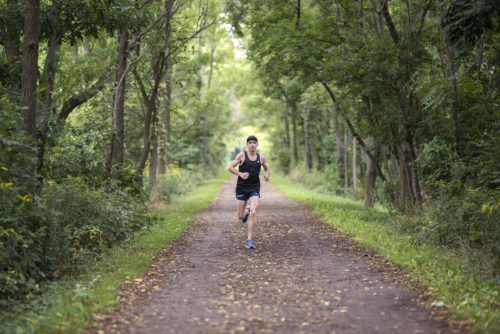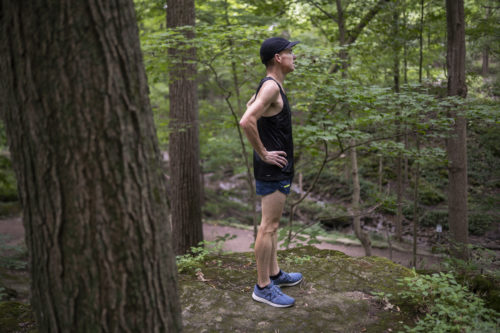REID COOLSAET, THE MOST PERSISTENT MARATHONER IN CANADIAN HISTORY, NEVER STOPS, NEVER SETTLES, NEVER QUITS
BY RAVI SINGH, PHOTOGRAPHS BY NICK IWANYSHYN
Anyone can get old. Not everyone can mature. Maturity in running is a balance between a hunger for growth and an ability to know ourselves. The immature athlete can cherry-pick situations where triumph and adulation are all but certain. They can also confront failure with anger and retaliation, grinding themselves down to constant injury or frustration and a feeling of worthlessness because an immediate goal failed to materialize.
The mature athlete seeks the discomfort of challenge. Their approach is not one of fear that they may be embarrassed or exposed, but one of optimism, embracing the possibility that new elements of adversity might plant the seeds that flourish into excellence. It’s also a matter of vulnerability and maintaining a sense of self-worth and a belief that one’s goals are valid, however messy the journey.
The mature athlete works beyond a single goal. To be at their most competitive, to emerge with new layers and strengths, to adapt along the way—these are their objectives. It’s the distinction between training with finite goals and infinite purpose.
I once asked Olympian Eric Gillis for the first phrase that came to mind when he heard the name Reid Coolsaet, his longtime Speed River training partner and occasional course rival. His response: “Trains with purpose.” Coolsaet first proved himself special in 2010 with a 2:11:23 at the Scotiabank Toronto Waterfront Marathon (STWM). At that time, he was among a group of four Canadian men—the others being Gillis, Rob Watson, and Dylan Wykes—who could target a sub-2:15 and all of whom trained together out of Guelph.
Years later, Reid has proven to be a standout among that group of standouts that emerged in the lead up to London 2012. He’s the only one of that group who is at this moment chasing the Canadian record and the only one to have recently threatened it. As a result of that quest, his name appears six times—more than any other—in the 20 fastest ever marathons run by Canadian men.
From his home in Hamilton, Coolsaet says, “I still feel like I’m an underdog. I’m sure that a lot of runners have seen my results and feel that I’ve always been accomplished, but it’s taken a long time to get where I am. Every time I entered a new level of competition, it’s been about working my way up.”This understanding, that every accomplishment would have to begin with a vision for long-term growth, balanced with an eagerness to do that work, is perhaps the foundation of Coolsaet’s longevity. “I still have a chip on my shoulder,” he says, “but the older I get the smarter I train and the smarter I race.”

In more than two decades of competition, he’s never stopped believing in his ability to learn. If that’s there—the desire to grow— Coolsaet believes he’ll keep running. So far, it’s taken him from a solid 1500 runner to one of Canada’s all-time best marathoners. On October 21st, Coolsaet returns to the Scotiabank Toronto Waterfront Marathon for the first time since 2011. Since then, the 39-year-old has become an Olympian, husband and father of two. If he achieves his longtime goal of running a sub-2:10 marathon at STWM, he’ll surpass Jerome Drayton’s 42-year-old Canadian men’s marathon record of 2:10:09 and add Canadian record holder to that list of titles. If he doesn’t, he’ll keep running.
Drayton tends to keep a low profile, but did say, “I wish Reid the best of luck,” upon hearing that Coolsaet would toe the line in October. Like Coolsaet, Drayton doesn’t look to the record for validation and will happily watch others succeed. Though Drayton hasn’t been glued to the running scene in the years since his retirement, he maintains a respect for the current field. Coach Dave Scott-Thomas has watched Coolsaet’s discipline and toughness develop since his days at the University of Guelph. Recalling his arrival, Scott-Thomas says, “He came as a good high school athlete and had an okay first year. At the end of the first year, we talked about what he might be able to do as a runner.”
During those conversations, Scott-Thomas remembers, “The electricity was just crackling off of him and he always had an ability to be ambitious, but also real about it. He has the hunger and will put the work in to get there.” 2018 alone has been a microcosm of that journey and further proof of what Scott-Thomas sensed in the early days. First, there was the now notorious Boston Marathon in April, which became a battle with the elements rather than a full-on race and ideal expression of fitness, but a battle that resulted in a top-ten finish. The Mexico City Marathon followed in September, an experience which Reid calls “interesting.”
“I just didn’t have it near the end and it was another mental battle,” he says. “I thought it would be easier, but I actually puked during the race and didn’t eat until later in the afternoon. I started sweating profusely and realized I picked up a stomach bug.” A twisted ankle then greeted Coolsaet on his return home. Tohavetwoconsecutivemarathonsnotgo according to plan due to unforeseen condi- tions can easily exhaust a runner’s spirit. It’s easier said than done, but to step back and see individual runs or races in a broader context is crucial to maintaining one’s sanity (and consistency). Coolsaet, experienced, is very much a big picture thinker—heading into October, he can still see the overall vision rending the way that he wants. While standout performances define his career for outside observers, he accepts his story as one with blemishes and doesn’t cling to perfectionism or comparison. He almost relishes in a pattern of setback followed by success, a pattern that sharpens the chip on his shoulder and further entrenches the firm belief in his purpose of being his absolute best at the marathon.

One of those outstanding performances came at the 2010 Scotiabank Toronto Water- front Marathon (STWM). “In 2010, I had a full, specific buildup with consistent running. When I first started thinking how fast I wanted to run I wanted to aim for 2:13 or 2:12, and then it went to 2:10 as the training progressed,” he says. “I was able to power through some hurt at the end and still ran 2:11.23, which was under the Olympic standard. It was one of the happiest moments of racing and I felt I hadn’t been on that level since 2007.”
Following 2010, Coolsaet assumed it was smooth sailing ahead with two marathons a year, picking up prize money along the way. The reality turned into one marathon per year due to frequent injuries. In the midst of those injuries, however, came a personal best of 2:10:28 at the 2015 Berlin Marathon. That followed an abdominal muscle ripping off the pubic bone in 2014. Another sub-2:11 came in 2016 at Fukuoka, another race preceded by injuries. In 2011, he recorded a 2:10:54 at STWM, netting a third overall finish.
It never seemed to derail Coolsaet that the path was never clear. Convinced that he hasn’t seen the best of himself yet, he’ll continue to pursue the marathon. When he returns to STWM in 2018, he’ll do so alongside New Zealand record-hol- der Jake Robertson (2:08 PB) and marathon rookie Cam Levins, the latter of whom Reid says can potentially break 2:10, though debuts are fraught with unpredictability. Canadians have made impressive debuts at the mara- thon before, including Rachel Cliff in Berlin and Rachel Hannah in 2015. Added into the STWM mix are returning champion Philemon Rono and 2012 Olympic champion Stephen Kiprotich, altogether comprising the strongest men’s field in the race’s history.
“If I wasn’t racing, I’d be on the sidelines or glued to my monitor,” says Coolsaet, a devotee of the sport and its practitioners. “I don’t have any delusions about running with Rono or Robertson, who might go 62 minutes for the first half. If I get in shape, I might run 65 for the first 21 kilometres.” After all these years under the spotlight, Coolsaet still refuses to abandon a race plan in favour of hype. Indeed, his appraisal of his race day poten- tial and place in the field is honest, but not spoken with any sense of disappointment. Running in such a deep field can be a learning expe- rience, something from which he’s never shied away because it allows him to do the hard work of understanding and further applying himself.
Drayton recalls the moment he made his move from the track to the marathon and to history. He never learned to love the drudgery of the track, Drayton relates, so much so that he dropped out of his first 10,000 m race simply because, “I got tired of hearing how many laps there were to go!” The inspiration for the marathon came when fellow Toronto Olympic Club member Andy Boychuk challenged, “Jerome, you’ll never be a man until you finish a marathon!”
In 2018, Boychuk’s taunt can be updated for inclusiveness and maintain it’s essential truth—“You’ll never know yourself quite like you will when you train for a marathon.” That basic truth, which connects every marathoner, is what took Drayton to victory at the 1977 Boston Marathon, three wins at Fukuoka, and the still standing Canadian record. The same truth still drives Coolsaet. The marathon still motivates his curiosity about who and what he is.
And so Coolsaet is content, but not complacent. He’s thrilled to find himself, his two children and wife Marie living in his native Hamilton once again. Marie, a former collegiate runner and Queen’s University captain, is the perfect companion on the journey. “Marie understands elite running and what it takes to excel,” he explains. He’s gleefully taking on the responsibilities of being Louis and Elodie’s dad. His accomplishments are formidable and he knows that, but there are unknowns still to explore. He’s still getting to know himself with every mile. Dave Scott Thomas says of one of his most successful proteges, “When he’s done, he’s going to know how good he was.” The ultimate decision maker on Reid’s ability isn’t a record or result, it’s Reid.






 Current Issue
Current Issue Previous Issue
Previous Issue Prior Release
Prior Release
